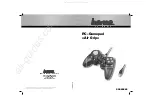
10-12
L90 LINE CURRENT DIFFERENTIAL SYSTEM – INSTRUCTION MANUAL
OVERVIEW
CHAPTER 10: THEORY OF OPERATION
10
Sequence numbers are also used to match messages for the protection computation. Whenever a complete set of current
measurements from all terminals with matching sequence numbers are available, the differential protection function is
computed using that set of measurements.
10.1.14 Start-up
Initialization in our peer-to-peer architecture is done independently at each terminal. Relays can be turned on in any order
with the power system either energized or de-energized. Synchronization and protection functions are accomplished
automatically whenever enough information is available.
After a relay completes other initialization tasks, such as resetting of buffer pointers and determining relay settings, initial
values are computed for any state variables in the loop filters or the protection functions. The relay starts its clock at the
nominal power-system frequency. Phaselet information is computed and transmitted.
•
Outgoing messages over a given channel are treated in the same way as during the channel recovery process. The
special start-up message is sent each time containing only a single time step value.
•
When incoming messages begin arriving over a channel, that channel is placed in service and the loop filters are
started up for that channel.
•
Whenever the total clock uncertainty is less than a fixed threshold, the phase locking filter is declared locked and
differential protection is enabled.
10.1.15 Hardware and communication requirements
The average total channel delay in each direction is not critical, provided that the total round trip delay is less than four
power-system cycles. The jitter is important and needs to be less than ±130 µs in each direction. The effect of a difference
in the average delay between one direction and the other depends on the number of terminals. In the case of a two or
three-terminal system, the difference is not critical, and can even vary with time. In the case of four or more terminals,
variation in the difference limits the sensitivity of the system.
•
The allowable margin of 130 µs jitter includes jitter in servicing the interrupt generated by an incoming message. For
both incoming and outgoing messages, the important parameter is the jitter between when the time stamp is read
and when the message begins to go out or to come in.
•
The quality of the crystal driving the clock and software sampling is not critical, because of the compensation
provided by the phase and frequency tracking algorithm, unless it is desired to perform under or over frequency
protection. From the point of view of current differential protection only, the important parameter is the rate of drift of
crystal frequency, which needs to be less than 100 parts per million per minute.
•
A 6 MHz clock with a 16-bit hardware counter is adequate, provided that the method described in this document is
used for achieving the 32-bit resolution
•
An eight-bit time stamp is adequate provided that time-stamp messages are exchanged once per cycle
•
A four-bit message sequence number is adequate
Depending on the 87L settings, channel asymmetry (the difference in the transmitting and receiving paths channel delay)
cannot be higher than 1 to 1.5 ms if channel asymmetry compensation is not used. However, if the relay detects
asymmetry higher than 1.5 ms, the
87L DIFF CH ASYM DET
FlexLogic operand is set high and the event and target are raised
(if they are enabled in the
CURRENT DIFFERENTIAL
menu) to provide an indication about potential danger.
10.1.16 Online estimate of measurement errors
GE's adaptive elliptical restraint characteristic is a good approximation to the cumulative effects of various sources of error
in determining phasors. Sources of error include power system noise, transients, inaccuracy in line charging current
computation, current sensor gain, phase and saturation error, clock error, and asynchronous sampling. Errors that can be
controlled are driven to zero by the system. For errors that cannot be controlled, all relays compute and sum the error for
each source of error for each phase. The relay computes the error caused by power system noise, CT saturation,
harmonics, and transients. These errors arise because power system currents are not always exactly sinusoidal. The
intensity of these errors varies with time, for example growing during fault conditions, switching operations, or load
variations. The system treats these errors as a Gaussian distribution in the real and in the imaginary part of each phasor,
Содержание L90
Страница 14: ...1 4 L90 LINE CURRENT DIFFERENTIAL SYSTEM INSTRUCTION MANUAL FOR FURTHER ASSISTANCE CHAPTER 1 INTRODUCTION 1 ...
Страница 68: ...2 54 L90 LINE CURRENT DIFFERENTIAL SYSTEM INSTRUCTION MANUAL SPECIFICATIONS CHAPTER 2 PRODUCT DESCRIPTION 2 ...
Страница 136: ...3 68 L90 LINE CURRENT DIFFERENTIAL SYSTEM INSTRUCTION MANUAL CONNECT TO D400 GATEWAY CHAPTER 3 INSTALLATION 3 ...
Страница 224: ...4 88 L90 LINE CURRENT DIFFERENTIAL SYSTEM INSTRUCTION MANUAL FLEXLOGIC DESIGN USING ENGINEER CHAPTER 4 INTERFACES 4 ...
Страница 692: ...6 36 L90 LINE CURRENT DIFFERENTIAL SYSTEM INSTRUCTION MANUAL PRODUCT INFORMATION CHAPTER 6 ACTUAL VALUES 6 ...
Страница 708: ...7 16 L90 LINE CURRENT DIFFERENTIAL SYSTEM INSTRUCTION MANUAL TARGETS MENU CHAPTER 7 COMMANDS AND TARGETS 7 ...
Страница 742: ...9 6 L90 LINE CURRENT DIFFERENTIAL SYSTEM INSTRUCTION MANUAL TESTING CHAPTER 9 COMMISSIONING 9 ...
Страница 804: ...10 62 L90 LINE CURRENT DIFFERENTIAL SYSTEM INSTRUCTION MANUAL FAULT LOCATOR CHAPTER 10 THEORY OF OPERATION 10 ...
Страница 872: ...C 6 L90 LINE CURRENT DIFFERENTIAL SYSTEM INSTRUCTION MANUAL COMMAND LINE INTERFACE APPENDIX C COMMAND LINE INTERFACE C ...
Страница 878: ...D 6 L90 LINE CURRENT DIFFERENTIAL SYSTEM INSTRUCTION MANUAL REVISION HISTORY APPENDIX D MISCELLANEOUS D ...
Страница 882: ...iv L90 LINE CURRENT DIFFERENTIAL SYSTEM INSTRUCTION MANUAL ABBREVIATIONS ...
Страница 900: ...xviii L90 LINE CURRENT DIFFERENTIAL SYSTEM INSTRUCTION MANUAL INDEX ...
















































